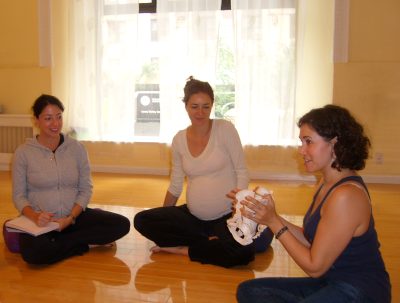A student asked me the other day how she should pick a birthing class. Her doctor had suggested she take one in preparation for her upcoming birth. She explained how overwhelmed she started to feel while she researched the different styles and methods of classes available. So this blog is intended to give you a “Cliff Notes” version of the different styles and also to briefly highlight what each method focuses on.
Lamaze
While the idea of “Lamaze” classes often conjure up the image of a woman panting to a dictated rhythm, that is far from the reality of Lamaze today. Lamaze International, as it is now referred to, focuses on providing evidence-based research in helping women build confidence and find good support in making decisions about how she approaches her pregnancy, birth and motherhood.
Lamaze classes highlight:
*Lamaze supports evidence-based pregnancy and birth practices that are supported by research and experienced childbirth educators.
*Lamaze guides you as you navigate all of your options, and their benefits and drawbacks.
*Lamaze seeks to empower you as you explore how your body was designed for birth, and encourages you to work with your body’s natural abilities.
*Lamaze provides strategies for natural pain management during labor, reducing unnecessary
medical interventions. Lamaze ensures that you feel continuously supported during labor and birth.
*Lamaze stresses the importance of natural pain management strategies through labor and birth, helping you choose methods that are safe and healthy.
*Lamaze encourages bonding between you and your baby, with the importance of skin-to-skin contact and time to get to know your new baby after birth. (1)
The structure of a Lamaze Class is 12-15 hours, usually 6 classes of 2-2.5 hours each. Lamaze teachers are also responsible for creating the outline of their own class, and class styles may vary as long as the required Lamaze Childbirth Education material is included and covered. In my experience, Lamaze is the most “middle of the road” method. It is more factual, and less experiential then some of the other methods. You are not likely to be spending lots of time on visualizations, birth art or explorations of birth fears.
The Bradley Method®
The Bradley Method® is taught in a strict 12 week class series. There is a specific week by week curriculum that each certified Bradley Method® follows. This method is very strongly focused on natural birth and including the partner as the “birth coach”.
The Bradley Method® describes itself as “is a system of natural labor techniques in which a woman and her coach play an active part. It is a simple method of increasing self-awareness, teaching a woman how to deal with the stress of labor by tuning in to her own body. The Bradley Method® encourages mothers to trust their bodies using natural breathing, relaxation, nutrition, exercise, and education.” (2)
Like the Lamaze method, Bradley Method® also focuses on the fundamentals of pregnancy and nutrition as well as the anatomy and physiology of the different stages of labor, variations and complications and postpartum health. There is also a whole class dedicated to constructing a birth plan. Participants also receive a 130 page study guide.
This method may not be suited for couples that are not focused on a drug free birth experience.
HypnoBirthing®
HypnoBirthing® focuses on the laboring mother using relaxation and hypnotic techniques to move into a state of relaxation and allowing her body to open without fear and trusting the natural process of birth. This philosophy of HypnoBirthing® is based on breaking the fear-tension-pain cycle. Basically when a person is fearful, the mental and physiological response is to get tense. (Tension causes a person to move into sympathetic nervous system which increases the heart rate, shortens breath and constrict the blood flow.) When the body is tense, pain is felt more intensely. If the laboring woman can feel more confident and trust the natural birthing process, the fear is removed and her body will be more relaxed, leaving her feeling less pain.
HypnoBirthing® does not claim to put the mother in a trance or to sleep. They state, “What you will experience is similar to the daydreaming, or focusing, that occurs when you are engrossed in a book or a movie or staring into a fire. In this calm state, your body’s natural relaxant, endorphins, replaces the stress hormones that constrict and cause pain.” (3) To achieve this outcome, this system relies heavily on the couple practicing the relaxation and visualization techniques that are given in the class.
The structure of HypnoBirthing® is similar to The Bradley Method®, in which there is a set curriculum. HypnoBirthing® is a 5 week program with each class running 2 1/2 hours long.
*Side note: I would also like to point out, there is very little focus on anatomy and physiology of the different stages of labor taught in the HypnoBirthing® system. Since they do not cover much of variations and complications of labor and cesarean births, I would consider HypnoBirthing® more of a pain management technique rather than a full childbirth education class. Granted, I am biased as a certified Lamaze teacher, but I think it is important for women and their partners to understand the broad scope of what labor will look like and have several pain management techniques to choose from in case one specific method does not work.
BIRTHING FROM WITHIN®
BIRTHING FROM WITHIN® is the exact opposite of HypnoBirthing® in that BIRTHING FROM WITHIN® classes are NOT about relaxing or “pain-free” birth. No need to bring pillows: you will not be relaxing, because the truth of labor is that it is hard work, and you may move better through labor by being upright, active, dancing, rocking, or sitting. You and your partner will learn about coping with pain and the challenges of labor, and have lots of time to practice together. “BIRTHING FROM WITHIN® is NOT outcome-focused. In other words, we do not promise that if you practice or believe in a certain thing, you will achieve a specific result. Your positive actions and intentions will influence your body-mind, but there is no way of knowing just how.” (4)
BIRTHING FROM WITHIN® is strongly based in approaching childbirth through a spiritual and holistic preparation. This method encourages the mother to explore her feelings around birth through “birth art” and discover not prescribed coping methods, but instead, discover more about herself.
Classes cover:
*Experience birth as a rite of passage
*Eat a sound diet (pregnancy and breastfeeding)
*Open your body-mind before and during labor with self-hypnosis and visualizations
*Build confidence in yourself and your partner
*Ask questions and make decisions in labor
*Protect your birth space
*Tame your “Birth Tigers”TM
*Push your baby out
*Welcome your baby
*Recover and plan postpartum
*Care for and feed your newborn
*Give birth from within during a Cesarean, while using pain medication, or with medical support.
BIRTHING FROM WITHIN® believes the essence of childbirth education is self-discovery, not assimilating obstetric information. Following in this philosophy, the do not offer research-based information about birth, or routines and policies of the hospital. They suggest if you are seeking this information to take a supplemental Lamaze or Bradley class, read an evidence-based book about birth or ask the “mentor” for additional information. Their focus is experiential, focusing on spiritual and holistic childbirth preparation.
The classes do not follow a specific curriculum; parents’ individual needs and differences determine class content.
International Childbirth Education Association (ICEA):
ICEA is a professional organization supports educators and other health care providers who believe in freedom to make decisions based on knowledge of alternatives in family-centered maternity and newborn care. (5) ICEA is very similar to Lamaze in the practice of presenting evidence based research, fully covering the anatomical and philosophical changes of pregnancy, teaching the different stages of labor, pain management techniques, reviewing interventions and complications and covering postpartum care.
“ICEA strongly supports the arrival of a baby is very much a “family affair”. ICEA believes family-centered care consists of an attitude rather than a protocol. It recognizes a vital life event rather than a medical procedure. It appreciates the importance of that event to the woman and to the persons who are important to her. It respects the woman’s individuality and her sense of autonomy. It realizes that the decisions she may make are based on many influences of which the expertise of the professional is only one. It requires that all relevant information be made available to the woman to help her achieve her own goals, and that she be guided but not directed by professionals she has chosen to share the responsibility for her care.” (5)
BirthWorks Intenational®
BirthWorks® classes are based on the philosophy that every woman is born with the knowledge about how to give birth. Therefore, birth is instinctive and what is instinctive doesn’t need to be taught. (6)
One component that sets BirthWorks® apart from some of the other methods is the strong focus on pelvic bodywork and optimal fetal positioning. They spend several classes focusing on this topic. The belief is, if the pelvis is well aligned, the baby will move into an optimal fetal position which leads to a more efficient labor.
BirthWorks® is taught in an 8 week series. The classes are interactive and experiential, providing both an academic and an emotional preparation for birth. BirthWorks® does cover the “basics” like medical procedures, VBACS, indications of a cesarean, birthing positions while also including a holistic approaching by encouraging participants to express fears about birth-related feelings. From my understanding it seems like a combo of Birthing From Within® and ICEA or Lamaze®.
I hope that this brief breakdown of these six different birthing techniques will help you decide what is right for you. Happy birthing!
For more reading, see this previous blog post: “Childbirth Education Classes” and “The Importance of Continuing Labor Support.”
Sources and websites for all the different birthing organizations
1. http://www.lamaze.org/
2. http://www.bradleybirth.com
3. http://www.hypnobirthing.com
4. http://www.birthingfromwithin.com
5. http://www.icea.org
6. http://www.birthworks.org







